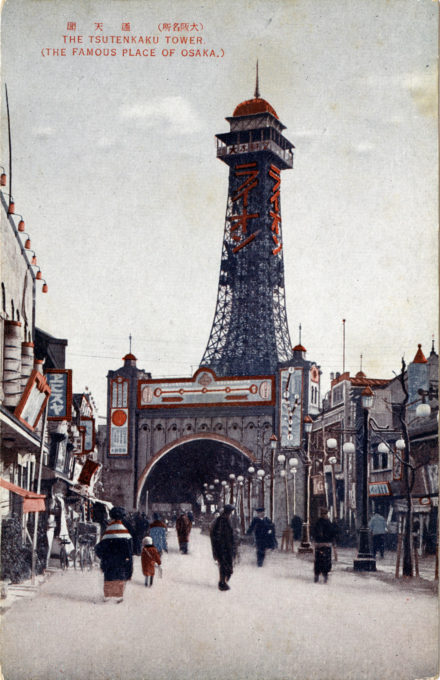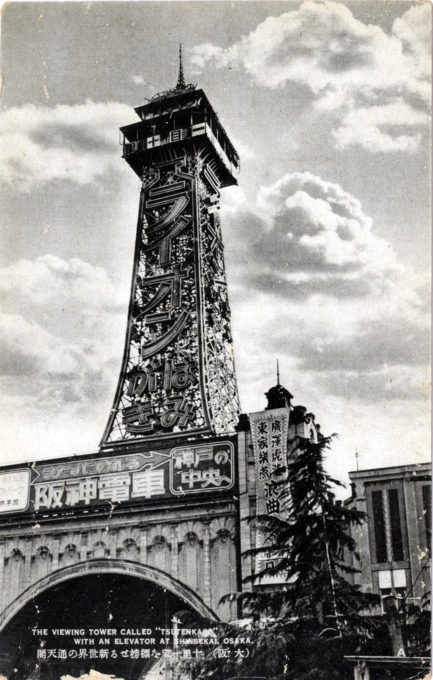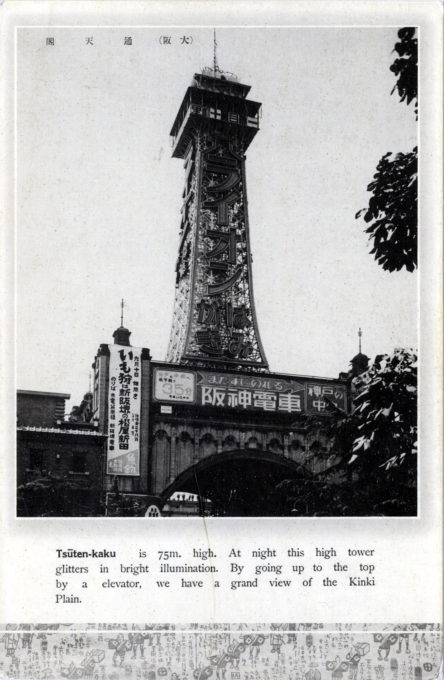[Note: The founder of Matsushita Electric, now known universally as Panasonic, apprenticed as an electrician in Osaka before founding his eponymous company in 1918. In his memoir, published in 1954, Matsushita Konosuke remembers:]
“The viewing tower called ‘Tsutenkaku,’ with an elevator at Shinsekai.” Tsutenkaku Tower, Osaka, c. 1930.
“Osaka Electric also did the wiring for the Tsutenkaku Tower, which was built in 1912 in the Shinsekai district after the model of the Eiffel Tower. This early Osaka landmark was torn down during World War II. At first the same company in charge of the construction was to do the wiring, but before it was complete, our company was asked to take over. Fourteen or fifteen of us were put on the job, and opening day was so close we had to hurry.
“Working high up inside the roof of the tower’s sightseeing pavilion, at first I felt dizzy and my legs would grow wobbly whenever I looked down. In two or three days, however, I grew used to the height, and was finally able to concentrate on my work.
“The attic of the pavilion contained an extremely complex structure. Although it looked quite plain from the outside, inside the ceiling was a forest of braces and girders. Its huge scale astounded me. For ten days we worked inside the ceiling, with only candles to illuminate the pitch black space where the wiring had to be done. Emerging into the broad daylight after several hours on the job filled us with indescribable joy and relief.”
– My Way of Life and Thinking, by Konosuke Matsushita, 1954
“The original tower, patterned after the Eiffel Tower and the Arc de Triomphe, was built in 1912, and was connected to the adjacent amusement park, Luna Park, by an aerial cable car. At the time of its construction, its height of 72 meters made it the second tallest structure in Asia. It quickly became one of the most popular locations in the city, drawing visitors from all over the area.
Tsutenkaku Tower, Osaka, c. 1940. “At night this high tower glitters in bright illumination. By going up to the top in a elevator, we gave a grand view of the Kinki Plain.”
“The original structure suffered a fire in 1943 which severely damaged it, and rather than repair the structure, it was disassembled and the steel used for the war effort. After the war, citizens lobbied to rebuild the beloved tower. A private company, the Tsūtenkaku Kanko Co. Ltd. was established and Tachū Naitō, Japan’s ‘Father of Towers’ [Landmark Tower, Yokohama; and Tokyo Tower, Tokyo] was selected to design it. The new, eight-sided structure was opened in 1956.”
“Billiken, a popular American charm doll that came to Japan in about 1910, was enshrined within Luna Park when it opened. When the park closed in 1923, the wooden statue of Billiken went missing. A replica of the statue was placed in the second-generation Tsutenkaku Tower in 1980.”
– Wikipedia




